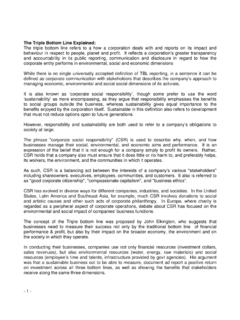Transcription of Speech Pathology and Respiratory Care 041113.ppt
1 4/11/20131 Speech Pathology and Respiratory CareApril 11, 2013By Angela Parcaro-Tucker, MA, CCC-SLP, LSVT How can Speech Therapy help?12 Respiratory Compromise and SwallowingSwallowing is a complex sequence of carefully timed oropharyngeal executions. A breakdown in any level of oropharyngealfunction may compromise a person s airway and Respiratory function. Penetration of airway: Food/liquid enters the laryngeal vestibule, but does not travel inferiorly below the vocal folds Aspiration: Food/liquid passes below the level of the vocal folds4/11/20132 Red Flags for AspirationInability to handle own secretions is a 100% indicator of aspiration.
2 Red Flags: orders to NT suction or suction PRN in absence of trach Wet or rattling sound to breathing at the level of the larynx Palpable rattle at the level of the and Symptoms of AspirationSigns and Symptoms that occur while or shortly after oral trials are given: Cough Throat clear Wet vocal quality Clear, thin nasal discharge Watery eyes Oxygen desaturation Increased Respiratory effort4/11/20133 Silent Aspiration Aspiration with NO cough or other obvious s/s. Sensory response is impaired; no protective mechanism to notify the body to cough to eject aspirated material Maybe suspected at bedside, provided that clinical picture supports likelihood of aspiration.
3 Can only be proven with extra diagnostic testing, such as Modified Barium Swallow Study (MBS) or Flexible Endoscopic Evaluation of the Swallow (FEES). A patient who is diagnosed with Silent Aspiration should not be passed for diet upgrade without passing diagnostic Silent Population Not Ventilator-DependentPrior to PMV trials: Should be able to tolerate being on Trach Shield Should be able to tolerate cuff deflation Should be able to demonstrate satisfactory air passage when trach is occluded with the finger. Bonus if they can produce voicewith finger occlusion!
4 7 PMV TrialsIf patient has been suctioned (if needed), and requisite tolerances are demonstrated, leave cuff deflated, and PMV is applied Patient is monitored carefully for tolerance. Maintenance of oxygen saturations Absence of other signs of distress SOA Facial reddening Extreme anxiety Excess coughing Buildup of secretions84/11/20135 Vocal quality is assessed by SLP Poor vocal quality may indicate vocal fold (VF) edema, paresis, paralysis, injury, etc. Depending on length of time patient has been intubated, it could take longer for poor vocal quality to resolve.
5 If poor vocal quality persists longer than expected by SLP, laryngoscopy or videostroboscopy may be indicated. ENT consult may be of Voice and Swallow in Ventilator Dependent Trach Population Require collaboration with Respiratory care to place the patient on speaking valve, or Passy Muir Valve (PMV) in line with the vent. Vent settings are adjusted by Respiratory care to allow cuff deflation and PMV placement. Monitoring for patient tolerance is a joint effort between the disciplines. Vocal quality and swallow is assessed by Speech Pathologist (SLP)104/11/20136 SwallowingPatient is suctioned one more time if needed prior to first trials by mouth.
6 PMV is put back on. WHY PMV with swallow? PMV placement normalizes pressure in the pharynx, allowing for more complete clearance of food/liquid from pharynx with swallow. Pharyngeal Sensation is improved with normalized pattern of airflow, providing for a swallow response that is more Evaluation with PMV1. Colored bolus (colored food/liquid of a particular consistency) is provided. is suctioned. Suction return is examined carefully for evidence of the color in the there is evidence of the color in suction return, that consistency is discontinued.
7 Another consistency may be attempted, depending on multiple factors and the SLP s clinical there is no evidence of the color in suction return, trials are expanded until a safe diet consistency is determined. Suctioning occurs between each consistency, to ensure that each individual consistency is assessed Diet and the Trach PopulationOrders for diet are written by SLP, including texture of foods and liquids, positioning of patient, placement of PMV for all PO, and suctioning by RN after each meal for the first 24-48 hours, with special attention to examining the content of suctioned material for evidence of food given.
8 If evidence of food is noted in suctioned material, the patient is to be NPO until reassessed by Cord Dysfunction (VCD)Also known as: Paradoxical Vocal Fold Motion (PVFM)What is it? The tendency of the vocal folds to closewhen a person is attempting to patient can have both asthma and VCD. Having VCD does not exclude one from having asthma, and vice of VCD The literature indicates that definitive diagnosis takes place during laryngoscopy, when the vocal folds are visualized to close upon inhalation or exhalation However, patients are often asymptomatic unless exposed to their triggers Differential diagnosis is the most common method of determining VCD is present Physician diagnoses based on patient s signs and symptoms, along with careful documentation of attempts to manage other medical Respiratory diagnoses such as asthma, COPD.
9 Basically, if asthma treatment fails, or starts to become less effective, AND the patient is describing s/s VCD, a physician may suspect VCD. PFT is often helpful in supporting VCD and VCDPFTs may show an aberration in flow loop, if a patient is in an active episode of VCD. Inspiratory, or expiratory, or BOTH flow loops may be depressed/flattened. VCD can occur on inspiration or expiration, or both, though it is most common on and VCD4/11/201310 visits and VCD misdiagnosis? Patients have occasionally been intubated or had emergency tracheostomies for VCD episodes Epinephprine is often given in the field or at ED, which may or may not yield results Anxiety medication is often given in ED Nasal cannula is often placed in ED, and patient is instructed to breathe through the and Symptoms of VCD It feels like my throat is closing off.
10 My chest gets tight, and then my throat closes off. My asthma medicines do not work (or only occasionally work). My throat makes a funny/squeaky sound when I breathe. (stridor) I cough when I m trying to breathe. (only with specific episodes with triggers, and when the cough is unproductive and described to be originating in the throat) It feels like there s something in my throat. 21 VCD Triggers Reflux (may be symptomatic, as in acid reflux/heartburn, but is usually asymptomatic, such as with Laryngopharyngeal Reflux (LPR)) Extreme temperature (cold/hot weather or cold/hot air) Humidity (shower, weather)










![[Angela Pearman] [Martin Place Chambers]](/cache/preview/1/1/8/4/4/3/d/0/thumb-118443d00252905dfdf47c90c3a5a550.jpg)

